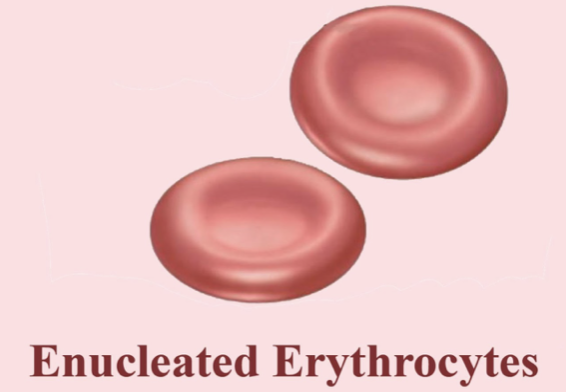
Give reasons for this sentence: A mature erythrocyte lacks a nucleus and mitochondria.
Answer
566.4k+ views
Hint: Erythrocytes are the small and most numerous blood cells. Mature mammalian Erythrocytes are non nucleated, circular, disc- like, and bio- concave without mitochondria. Mature Erythrocytes are known to have a high capacity to accommodate more hemoglobin hence carry more oxygen molecules.
Complete answer:
A mature erythrocyte lacks nucleus and mitochondria so as to make a place for the accommodation of more hemoglobin and hence more oxygen molecules. Lack of such organelles also provides the peculiar biconcave appearance of RBCs that aids in efficient diffusion. Young mammalian RBCs are nucleated.

But, as they mature, they lose their nucleus and membrane- bound cell organelles. A mature Erythrocytes consists of a spongy network, known as the stroma. It is enveloped by a limiting plasma membrane.
Additional Information:
- Biochemically Erythrocytes are formed of water, hemoglobin, enzymes, organic constituents, and inorganic constituents.
- The average life-span of Erythrocytes is 129 days. It is estimated that nearly 3 million RBCs die every second. To compensate for this, an equal or still greater number is produced in the bone marrow.
- Normally, the rates of production and destruction of RBCs are mutually balancing. The rate of production of RBCs is determined by the oxygen level in the blood.
Note:
- Worn out corpuscles undergo breakdown in the liver and spleen. During this, the globin part of its hemoglobin gets degraded to amino acids.
- The iron atom of the haem part is stored in the liver in the form of an iron- containing protein called ferritin. It would be used again for the synthesis of hemoglobin or cytochromes.
- Erythrocytes transport respiratory gases. They help in the maintenance of normal blood pH and ionic equilibrium. They help in the formation of bile pigments by the degradation of hemoglobin.
Complete answer:
A mature erythrocyte lacks nucleus and mitochondria so as to make a place for the accommodation of more hemoglobin and hence more oxygen molecules. Lack of such organelles also provides the peculiar biconcave appearance of RBCs that aids in efficient diffusion. Young mammalian RBCs are nucleated.

But, as they mature, they lose their nucleus and membrane- bound cell organelles. A mature Erythrocytes consists of a spongy network, known as the stroma. It is enveloped by a limiting plasma membrane.
Additional Information:
- Biochemically Erythrocytes are formed of water, hemoglobin, enzymes, organic constituents, and inorganic constituents.
- The average life-span of Erythrocytes is 129 days. It is estimated that nearly 3 million RBCs die every second. To compensate for this, an equal or still greater number is produced in the bone marrow.
- Normally, the rates of production and destruction of RBCs are mutually balancing. The rate of production of RBCs is determined by the oxygen level in the blood.
Note:
- Worn out corpuscles undergo breakdown in the liver and spleen. During this, the globin part of its hemoglobin gets degraded to amino acids.
- The iron atom of the haem part is stored in the liver in the form of an iron- containing protein called ferritin. It would be used again for the synthesis of hemoglobin or cytochromes.
- Erythrocytes transport respiratory gases. They help in the maintenance of normal blood pH and ionic equilibrium. They help in the formation of bile pigments by the degradation of hemoglobin.
Recently Updated Pages
The number of solutions in x in 02pi for which sqrt class 12 maths CBSE

Write any two methods of preparation of phenol Give class 12 chemistry CBSE

Differentiate between action potential and resting class 12 biology CBSE

Two plane mirrors arranged at right angles to each class 12 physics CBSE

Which of the following molecules is are chiral A I class 12 chemistry CBSE

Name different types of neurons and give one function class 12 biology CBSE

Trending doubts
One Metric ton is equal to kg A 10000 B 1000 C 100 class 11 physics CBSE

Explain zero factorial class 11 maths CBSE

What is 1s 2s 2p 3s 3p class 11 chemistry CBSE

Discuss the various forms of bacteria class 11 biology CBSE

State the laws of reflection of light

An example of chemosynthetic bacteria is A E coli B class 11 biology CBSE




